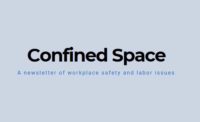A Confined Space blog post
Acosta testifies and he’s not terrible
Posted with permission from Confined Space, a newsletter of workplace safety and labor issues.
Secretary of Labor Alex Acosta testified last Thursday at a hearing before the full House Education and Workforce Committee, and although I take great pleasure in (deservedly) criticizing Trump administration appointees, he wasn’t terrible — as Trump appointees go.
Now let me qualify a bit. I’m focusing only on workplace safety issues, not on any wage and hour, apprenticeship or other labor issues that were addressed during the hearing. Second, his performance varied from fairly decent (regarding enforcement issues) to pretty bad (regarding standard setting and staffing.) And, of course, we’re grading on the Trump-Republican grading curve (which includes Cabinet heads like Scott Pruitt, Rex Tillerson, Betsy DeVos, Ben Carson, Jeff Sessions, Steve Mnuchin and Rick Perry.) We’d grade on a different curve if it was a Democratic administration, or even if it was a more, umm, competent Republican cabinet.
Ranking Member Bobby Scott (D-VA) warned in his opening statement that
Staffing
Acosta also announced in his opening remarks that “In August 2017, I provided OSHA with blanket approval to hire OSHA Compliance Safety and Health Officers, streamlining the hiring process to bring new OSHA staff on board in an expedited manner to ensure that OSHA has the necessary personnel to carry out its important work.”
While it is true that he lifted the hiring freeze for OSHA CSHOs (inspectors), the process is anything but streamlined from what I hear. Approvals for CSHO hiring are trickling out at a snail’s pace, barely keeping up with retirements. And the agency doesn’t live by CSHOs alone. Whistleblower investigators still fall under the hiring freeze, and the backlog of cases which had been coming down during the Obama administration, is apparently on the rise again. Furthermore, unless you also start hiring mid-level managers and administrative people, the enforcement process slows down as it takes longer to get large cases through and the CSHOs have to do the work that the administrative people should be doing. Retirements don’t happen evenly, so some Area and Regional Offices are hit much harder than others. And of course, the longer an enforcement case takes to issue, the longer workers are forced to work in hazardous workplaces.
Workplace Violence
Joe Courtney (D-CT) asked Acosta about workplace violence and the uptick in workplace violence incidents. He described a particularly upsetting assault on one of his constituents and noted that the last administration committed to using the General Duty clause and setting new standards. “This is a real issue and the fact that the department has suspended that initiative is kind of amazing to those of us who have been following this issue. Do you think that workplace violence is an important issue to issue standards “to protect the caregivers in our society? ”
Acosta responded that he had absolutely no intention of doing any rulemaking around workplace violence, and even if he wanted to, the White House wouldn’t let him. Actually, he wasn’t really that honest. What he actually said was that he thought that “Certainly workplace violence is a very important issue to address.” But then added the familiar Congressional witness cop out for all Administration witnesses who don’t really want to say “Go to hell” in so many words: “I’m happy to follow up with your staff to get some more details on your particular concern. ” (Translation: I have no intention of moving anywhere on this issue, but always happy to send OSHA staff over to Capitol Hill for you to beat up on my behalf.)
Silica: Keeping Hope Alive
Tim Walberg (R-MI) complained about OSHA’s silica standard which went into effect last month, claiming that it is “extremely challenging to implement and comply with this rule.” He asked if Acosta was willing to impose a further stay of the rule. Acosta responded that he had already allowed a 30 day exension, hoping that the parties suing the agency would be able to reach a settlement, which was unsuccessful. But he hasn’t given up hope: “My hope that parties can come together and find a sensible outcome to this rule.”
Congressman Rick Allen (R-GA), who was in the construction industry for 35 years before coming to Congress, was also upset and somewhat confused about the Silica standard, asking if the rule had been finalized and was now being implemented. (The answer is yes. Finalized in March 2016 and fully enforced as of last month.) Allen claimed that “I have people out pricing and getting quotes and its very expensive to deal with. Are they to comply with this rule now? What if it changes? It’s very expensive to comply with.” He complained that there is an awful lot of confusion. Employers are faced with “huge” costs. They had no way to know what to anticipate. (Really? It’s been on the reg agenda since 1997, the proposal was issued in 2014, and the final was issued over a year and a half ago.) “It’s VERY complicated, Allen continued. “Is there any way OSHA can clarify what’s going on and can say this is where we are and can give industry some time to adapt. Because its very costly and they’re on fixed costs and don’t put compliance things into costs and predictability is critical.”
Acosta conceded that the standard had “complicated and has multiple dates.” Parts are in effect now (construction),and parts will come into effect after some time (General Industry). He again assured Allen that “Parties in litigation close to settlement. If there’s common ground, we should look for common ground. I was disheartened that parties didn’t come to table until right up to the deadline.” And he assured the Congressman that the agency was engaged in efforts to clarify silica information and will redouble those efforts. OSHA has issued lots of educational materials. He may want to point his constituents to OSHA’s silica webpage.
What Acosta was really saying is “Forget it.” Barring some surprise reversal in court or some slight modifications as a result of negotiations between concerned parties, the Silica Standard is here to stay. It’s way to big and way too well constructed to repeal. We even defended it it court. I’ve delayed enforcement a couple of times and OSHA has developed some more educational materials, but that’s all you’re getting. So get with the program and protect your workers.
Confrontation vs. Cooperation
Acosta, in his opening statement, stated that
He also had some kind words to say about OSHA’s Voluntary Protection Programs call it “a robust cooperative compliance assistance program that prevents workplace fatalities, injuries, and illnesses.” and noted that “OSHA is currently examining VPP and reviewing public input as it considers changes to the program.”
Congressman Lloyd Smucker (R-PA) complained that although most employers understand it is important to provide a safe workplace for their employees, he was concerned that the approach OSHA has taken over the last number of years was “more “punitive” than collaborative.” Why aren’t businesses receiving assistance to provide a safety workplace?
Acosta responded that he had requested additional funding for the Voluntary Protection Programs. “In general where employers are trying to do the right thing, you want to help them.” But he then pivoted to enforcement affirming that compliance assistance ”
Glen Grothman (R-WI) accused OSHA inspectors of coming in to write citations (sometimes with press releases!!) about “relatively miner things that are easily correctable.” He asked Acosta if he had plans “to reign in OSHA.”
Acosta responded that where you have individuals who are trying to comply there is a value to compliance assistance. But “on the flip side, if you have an employer who is engaged in willful and repeat violations, that have resulted in serious harm, you need to be very aggressive in enforcement….Compliance Assistance goes hand in hand with aggressive enforcement.”
Rep Mark Desaulnier (D-CA) asked Acosta if he had ever attended the funeral of American worker who has lost their life n a workplace accident? DeSaulnier went on to describe the grusome death of some of his constituents in refinery incidents. “So when I see an agency whose budget is being cut and staffed at a 1990’s level where it would take 159 years. So forgive me with being cynical.”
Acosta sympathized with the tragedy of workplace fatalities: “I understand the point your’re making and we prosecuted a similar incident criminally in Miami.” He claimed to be “very much aware of the importance of vigorous prosecution when violations are willful or repeat.” He stressed that he was perfectly fine referring willful and repeat violations to the Justice Department for criminal prosecution. “Where you have a culture that is not compliant and that disregards safety matters, that can be a criminal violation.”
OK, I’ve discussed a number of times before (here and here) my feelings about VPP and compliance assistance. The fact is, no matter how many nice words he has to say about VPP, the agency does not have the budget to grow the program significantly without either sacrificing enforcement resources or the integrity of the VPP program. But I am gratified to see Acosta bringing up the need for strong enforcement and even criminal prosecution. Of course, the proof will be in the proverbial pudding, but it’s still nice to see the words coming out of a Trump administration official.
Recordkeeping
DeSaulnier raised the Trump administration’s delay of the last administration’s electronic recordkeeping standard which would have provided efficiency and better results to the agency’s enforcement efforts and asked if he was planning on making this work December 1. Acosta responded that OSHA is reviewing the injury and illness record-keeping rule with an eye toward “balancing the issues of privacy with the agency’s need for companies’ worker injury data to help prioritize inspections.” He then erroneously claimed that the rule “was asking for some information that was very detailed and that identifies individuals.”
Conclusion
Again, all in all, not a bad performance by a Trump administration Cabinet head — at least as far as health and safety issues go. But that was the Secretary speaking. We still don’t have a permanent Assistant Secretary, and it’s unlikely that Trump’s nominee, Scott Mugno, will be confirmed until Spring. Right now, the agency is being managed — or more accurately, not managed — by Deputy Assistant Secretary Loren Sweatt. Mostly, the career staff are running the place, which is not a bad thing. We’ll know more about the direction the agency is heading when Mugno appears at his as-yet-unscheduled confirmation hearing.
Click here to visit Confined Space.
Looking for a reprint of this article?
From high-res PDFs to custom plaques, order your copy today!





